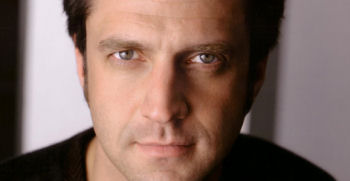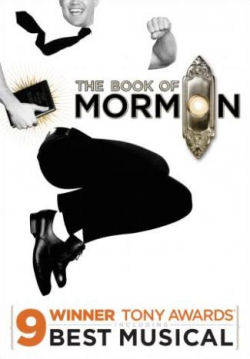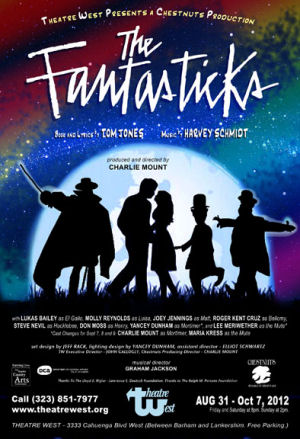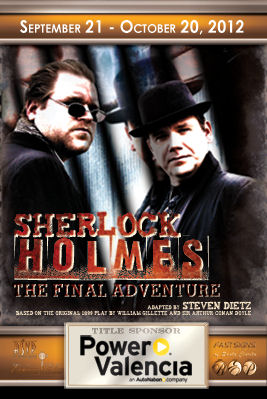
 Camp. Usually, when I talk about camp, I’m referring to an excellent facility in Malibu, but this time I’m referring to the theatrical meaning: “deliberately exaggerated and theatrical in style, typically for humorous effect“. Now consider two “camp” musicals: one based upon a completely serious movie that won Best Picture in 1991; the other was based on a movie that was nominated for “Worst Picture” in the first year of the Razzie Awards. Very different sources… and yet both succeed. The first succeeds because it takes its material seriously and is faithful to it; the second succeeds because it goes beyond its material to construct a show that the New York Times called “simultaneously indefensible and irresistible” (which it is). How do I know this? Last week I saw the former–“Silence! The Musical“. This week, I was at the DOMA Theatre group (at the Met Theatre) where I saw the latter–“Xanadu (on Broadway)“.
Camp. Usually, when I talk about camp, I’m referring to an excellent facility in Malibu, but this time I’m referring to the theatrical meaning: “deliberately exaggerated and theatrical in style, typically for humorous effect“. Now consider two “camp” musicals: one based upon a completely serious movie that won Best Picture in 1991; the other was based on a movie that was nominated for “Worst Picture” in the first year of the Razzie Awards. Very different sources… and yet both succeed. The first succeeds because it takes its material seriously and is faithful to it; the second succeeds because it goes beyond its material to construct a show that the New York Times called “simultaneously indefensible and irresistible” (which it is). How do I know this? Last week I saw the former–“Silence! The Musical“. This week, I was at the DOMA Theatre group (at the Met Theatre) where I saw the latter–“Xanadu (on Broadway)“.
The 1980s were an interesting time. I know — I was there, in college, at UCLA. Olivia Newton John was at the top of the pop charts, and was coming off her success in the film version of the musical “Grease“. Her next film, however, was a box office disaster (although the album went double platinum): “Xanadu“. Xanadu, which also starred Gene Kelly in his last non-documentary performance, told the improbable story of Sonny, a record jacket artist. Sonny thinks his art is going nowhere and is about to give up when he is to paint an album cover for a group called The Nine Sisters. The cover features a beautiful woman passing in front of an art deco auditorium; this same woman collided with him earlier that day, kissed him, then roller-skated away, and Malone becomes obsessed with finding her. He finds her at the same (but now abandoned) auditorium. The woman is Kira, and she inspires him to revive the theatre and turn it into a roller disco. Kira is, in reality, Terpsichore, a greek muse, come to Earth disguised with roller skates and an Australian accent. She also inspired Danny Maguire, who originally built the threatre. The story goes on from there — you can read the full synopsis on Wikipedia — but it gets sillier. The only redeeming aspect of the movie was the music — all Olivia Newton John and Electric Light Orchestra (ELO). For the stage production, the music is credited to Jeff Lynne (who wrote the ELO songs) and John Farrar (who wrote the Newton-John songs). There were a few additional songs interpolated into the stage production.
In the mid-2000s, original producer Rob Ahrens came to book-writer Douglas Carter Beane with an idea.. an idea to take the film Xanadu and put it on stage. After a number of drafts and rewritings (all detailed in the liner notes to the CD) they came up with a book that kept the basic plot of the movie, but added elements of Clash of the Titans and more Greek mythology. The end result was a story whose goal was just to have fun: it could be self-referential and break the fourth wall; it could be a commentary on the state of the arts in the 1980s (a year that saw Barnum and Evita nominated as the best musicals), as well as a commentary on the state of society. In other words, it was fluff that knew it was fluff, and decided that since it was fluff, it was going to have fun.
The end story was as follows (edited down from Wikipedia): Chalk artist Sonny Malone is dissatisfied with his sidewalk mural of the Greek Muses and determines to kill himself. On Mount Olympus, Clio (the muse of history) convinces her eight sisters to travel to Venice Beach (rising out of the sidewalk mural) to inspire Sonny. Zeus’s rules require that Muses must always be disguised from mortals, so Clio wears roller skates and leg warmers, sports an Australian accent, and changes her name to Kira. Kira inspires Sonny to combine all the arts and “something athletic” all into one spectacular entertainment: a roller disco. Two of Clio’s sisters, Melpomene (the oldest sister, and the muse of tragedy) and Calliope (the muse of epics), are jealous that Clio is the leader of the Muses and that Zeus had promised “Xanadu” to her. . So they plot to discredit Clio and cause her banishment by tricking her into breaking one of Zeus’s rules: a Muse must not fall in love with a mortal, so they will curse “Kira” and Sonny to fall in love. Sonny finds a good location for the roller disco–a long-abandoned theater in Los Angeles called “Xanadu.” Inspired to locate the owner, he sets up a meeting with real estate mogul Danny Maguire. At the meeting, Sonny tries to convince Danny to donate the theater for the roller disco, because it would bring the arts to the district and drive up real estate values (yeah, like theatre does good things for a neighborhood :-)). But Danny scoffs, even though he had plans to open the theater himself, once upon a time, when he was inspired by an old love and dance partner of his, who looked suspiciously like “Kira,” named Kitty. But a flashback convinces him to redeem himself now by opening the roller disco with Sonny. Danny finds Sonny and tells him that if he can get the disco up and running in one day, he’ll give him 25% of the take from the Disco. Sonny finds “Kira” and tells her the good news. She is not impressed with the deal that he has cut. The evil sisters work their curse, and the winged Eros, along with “Mama Cupid”, shoots “Kira” and Sonny with the arrows of love. “Kira” is soon overwhelmed with guilt over her loving feelings and of having created her own art (a hand-drawn picture) alongside Sonny – both violations of Zeus’s restrictions on the Muses. With the help of some of the muses, “Kira” and Sonny fix up the old theater, and Danny agrees to go ahead with the opening. Clio realizes that she is falling in love with Sonny and tells him that she must leave. To make it worse for Clio, the evil sisters offer Danny piles of money if he will tear down the theater and build condos. Danny can’t resist and tells Sonny that the deal is off. “Kira” comes back to tell Sonny that she loves him, but the evil sisters tell her that she has broken Zeus’s rules, and that she must tell Sonny the truth. So “Kira” reveals all to Sonny, including that her name is Clio, but he does not believe her and is upset. He suggests that she is a crackpot. He also doubts that she really loves him, and she is angry and hurt. The evil sisters have triumphed, and Kira sets off for Mount Olympus to receive her punishment from Zeus. Meanwhile, Sonny and Danny discuss “Kira” and after seeing her in the sky, it all makes sense. Danny tells Sonny not to let go of his muse because of foolish pride as he once did back in the 1940s. Sonny, realizing that he really loves “Kira,” decides to find her – even if it means climbing Mount Olympus. I’ll leave the actual end open.
A silly story. As you can see, there were a number of changes from the movie. The mural aspect was brought back and the record album cover stuff was dropped (along with some stupid subplots). The Greek mythology aspects were strengthened, and the notion of evil sisters wanting to get even (common in Greek stories) was brought in. Further, the story built up the comedy, as two of the muses (comedy and dance) are actually played by men. Doma expanded on this a bit more, adding in references to current Los Angeles and the current weather, as well as amping up the commentary on the state of the theatre. It worked, and worked well. The story itself ended up being a fun-filled romp. The credit for keeping this a success probably goes to the director, Hallie Baran (FB), who make successful tweaks and kept the environment fun.
But the story isn’t everything. It takes a talented performance team to bring it to life. For this, DOMA’s team was about 95% there. They were strong in the acting and fun department, great in the roller skating, and just a tad weaker at points in the singing and dancing (although perfection is not the goal of this musical). In the lead positions were Lovlee Carroll* (FB) as Clio/Kira and Matt O’Neill* (FB) as Sonny Malone. Carroll was great as Clio/Kira, although at times the Australian accent overtook her. She was good at singing and movement, and had the comic moves down well. Her look wasn’t quite what I expected (she’s not an ONJ-clone), but it worked. O’Neill had strong comic timing, acting chops and moved well, although at a few points his singing voice was a bit off. But that was minor and really didn’t detract from the show.
In the second tier of named characters we had David Michael Treviño* (FB) as Danny Maguire/Zeus, Veronica Scheyving (FB) as Melpomene (muse of tragedy)/Medusa, and Brittany Rodin/FB as Calliope (muse of epic poetry)/Aphrodite. Treviño was very impressive — a strong singer, a strong dancer, and a strong actor who drew your attention whenever he was on stage. Scheyving was a hoot as Melpomene — she obviously grew up in the 1980s and didn’t need a choreographer to teach her the moves; she moved as if she knew them from “back in the day”. She was also extremely strong in her comic abilities, and played the comedy well. Alas, she was one of the others who had a few weak singing points, but again this didn’t detract overall as it worked with the comic effect. Lastly, Rodin was effective as Melpomene’s evil underling (isn’t there always one), playing, singing and dancing well.
Rounding out the ensemble in various roles were Bradley Sattler (FB) (Thalia – muse of comedy, Siren, Young Danny, Tubes Singer, Cyclops), Taji Coleman* (FB) (Euterpe – muse of song and elegiac poetry, Siren, Andrews Sister, Thetis), Lindsay Zana (FB) (Erato – muse of love poetry, Siren, Andrews Sister, Eros, Hera), Alan Lee (FB) (Terpsichore – muse of dance, Siren, Tubes Singer, Hermes), and Allyson Blackstone (FB) and Morgan Gallant (FB) as Dancers. Sattler and Lee were great as the male muses: Sattler played up the comedy quite well, and Lee’s dancing was spectacular (most guys can’t do splits like that). Coleman and Zana were also good in their various roles, although at a few points there movements felt more like choreography and less fluid, but hopefully that will go away as they do this more. Blackstone and Gallant were mostly in the background, but moved quite well especially when their movements were mirroring each other.
[* denotes members of Actors Equity]
Also up on stage was the band. This was the first time I’ve seen an almost completely female band, and to see full credits for the band members in the program. Bravo, or should I say Brava, for doing that. The band was also dressed (at least the female members) as muses, and were introduced as Polyhymnia, the muse of music and Urania, the muse of astronomy. The band, under the musical direction of Chris Raymond (FB) (keyboards 1) consisted of Emily Cohn (FB) (keyboards 2), Molly Miller (FB) (guitar), Anna Stadlman (FB) (bass), and Anjilla Piazza (FB) (drums). They were great, and the sound was wonderful.
Rounding out the creative side of the team was Angela Todaro (FB) as Choreographer. I wasn’t much of a dancer ever, let alone in the 1980s, so I can’t attest to how true the moves were to the 1980s. In general, the moves looked good, and everyone was having fun. At a few points the dancers came off a bit more mechanical (i.e., as if they were still thinking about the moves). This may go away as the production matures; it might also reflect the youth of the team (most of whom were probably infants during the era in question). Todaro did do remarkable things with the skates, and throughout the production the movement was just fun to watch.
A few notes before I turn to the technical. There were a number of points where the production was either updated or ad-libbed, and that worked quite well. I really liked the reaction when there were a few folks that arrived late (hint: not a good thing to do), and I liked how they placed the Xanadu theatre at the exact location of the Met. There were also some great comments about the state of the arts — in particular theatre — in the 1980s. The execution of the script was a hoot, and you’ll just have a good time seeing this despite the occasional minor weakness.
Turning now to the technical. The set by Amanda Lawson (FB) had its strong and weak points. It placed the band well and established the action good, and the prop pieces (in particular the telephone booth) worked well. However, I never got the sense of the muses emerging from the original mural — that aspect could be improved and would help the story. The lighting by Johnny Ryman/FB and Dean Wright (FB) was very effective and contributed well to the atmosphere of the piece. The sound (by David Crawford) was very good, particularly the vocal effects. The costumes by Michael Mullen (FB) were effective and worked well (with one exception: I didn’t realize that characters were meant to be either The Tubes or the Andrews Sisters), and captured the 1980s quite well. Jennifer Bendik (FB) was the stage manager, assisted by Ilia Kemble (who was also prop mistress). Cesar Martinez/FB was the house manager. Danielle DeMasters/FB was the production manager, assisted by Timothy Miller/FB. Jason Henderson/FB was the technical director.
A few last notes. The A/C at the Met Theatre was overtaxed by the heat we had yesterday, and it was quite warm at the top of the risers. Parking near the Met is tight, so arrive early if you want to get a good parking space. Lastly, handing out tickets for free admission at Skateland in Northridge is a nice touch!
Xanadu continues at DOMA Theatre Group (at the Met) through October 7. You can get tickets through the DOMA Online Box office, and you may be able to find them on Goldstar, LA Stage Tix, or Plays411.
Upcoming Theatre and Concerts: The penultimate weekend in September takes us to the Celebration Theatre in Hollywood for the musical Justin Love. The month ends with “Sherlock Holmes: The Final Adventure” at REP East on September 29. October brings some traveling for family with the bat-mitzvah of a cousin in Fresno, and Karen will be travelling for the Pacific International Quilt Festival in Santa Clara. Still, what’s a month without theatre, so… October will start out with “The Fantasticks“ at Theatre West on 10/6. That will be followed by “American Fiesta” at the Colony Theatre on 10/13, “The Book of Mormon” at Broadway LA/The Pantages on 10/27, and “1776” at Cabrillo Music Theatre on 10/28. Continuing the look ahead: November will bring “Moonlight and Magnolias” at REP East, which is booked for the end of the month. It may also bring “Seminar” at The Ahmanson Theatre (still undecided on ticketing; another possibility is “Ruddigore” at the Sierra Madre Playhouse) and may bring a concert performance of Raul Esparza at VPAC, especially if Erin flies in for it (he’s singing on her birthday). Non-theatrically, it will also bring “Day Out with Thomas” at OERM (certainly on some or all of Veterans Day weekend – November 10-11). Lastly, to close out the year, December has nothing formally scheduled (other than ACSAC), but will likely bring “Anything Goes” at the Ahmanson, and may bring “Judy Collins” at VPAC. Lastly, what few dates we do have open may be filled by productions I see on Goldstar, LA Stage Tix, Plays411, or discussed in the various LA Stage Blogs I read (I particularly recommend Musicals in LA and LA Stage Times).

 Yesterday was my daughter’s 18th birthday. It was also the day that Raul Esparza was going to do a concert at the Valley Performing Arts Center. Erin loves Raul Esparza, and really wanted to go; alas, she is now up in Berkeley and was unable to get down. She got her nose pierced instead (which looks nice, but we do have the traditional parental stance). In Erin’s absence, we went to the concert. This write up is partially for her*.
Yesterday was my daughter’s 18th birthday. It was also the day that Raul Esparza was going to do a concert at the Valley Performing Arts Center. Erin loves Raul Esparza, and really wanted to go; alas, she is now up in Berkeley and was unable to get down. She got her nose pierced instead (which looks nice, but we do have the traditional parental stance). In Erin’s absence, we went to the concert. This write up is partially for her*.


 The last few weeks we have all been inundated with politics. It comes to us over the airwaves, over the Internet, over the phones. Our friends talks to us about it, and it fills our Facebook feeds. It is even on our stages with
The last few weeks we have all been inundated with politics. It comes to us over the airwaves, over the Internet, over the phones. Our friends talks to us about it, and it fills our Facebook feeds. It is even on our stages with 
 Hello. My name is Elder Guy, and I would like to share with you this most amazing show… (ding-dong)
Hello. My name is Elder Guy, and I would like to share with you this most amazing show… (ding-dong)
 Last night, we saw a play about China. Well, not exactly China. Dinnerware. To be specific, last night we saw the play “
Last night, we saw a play about China. Well, not exactly China. Dinnerware. To be specific, last night we saw the play “
 Back in 1960 (shortly after I was born), a musical premiered off-Broadway. It ran, and continued running, for 42 years. It was then revived, and
Back in 1960 (shortly after I was born), a musical premiered off-Broadway. It ran, and continued running, for 42 years. It was then revived, and 
 After last night’s production, I turned to my wife and said, “You know, you can just tell that those two guys are really good friends.” What’s interesting is that I was talking not only about the two lead characters in the play, but the actors playing them as well. If you hadn’t deduced it yet, I might as well reveal that I was talking not only about the two fictional best-buds,
After last night’s production, I turned to my wife and said, “You know, you can just tell that those two guys are really good friends.” What’s interesting is that I was talking not only about the two lead characters in the play, but the actors playing them as well. If you hadn’t deduced it yet, I might as well reveal that I was talking not only about the two fictional best-buds, 
 People think of Hollywood as this liberal community, but is it really? There is often this image of Hollywood as accepting and full of gay actors, but is it really? Does the public accept gay actors in major action adventure roles? What would happen if a major action adventure actor (think an
People think of Hollywood as this liberal community, but is it really? There is often this image of Hollywood as accepting and full of gay actors, but is it really? Does the public accept gay actors in major action adventure roles? What would happen if a major action adventure actor (think an 